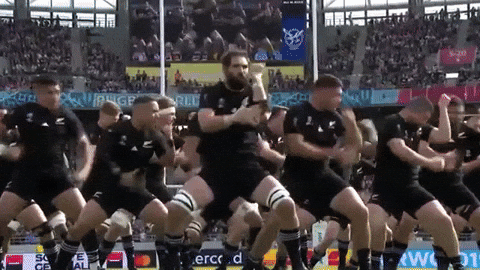How to Workout for Rugby
The sport of rugby is extremely complicated. We have to begin by deciding if we are looking at the 15s or the 7s. Although the 7s is in the Olympics, we are going to discuss the 15s. When we talk about the 15s, the game is a lot longer. There are also more athletes on the field. More athletes on the field can make play a little bit more complicated. Along with the length of the game being longer, the break at the half is longer. This longer half enables athletes to be a little bit bigger. With bigger athletes, the scrumming, the mauling, the sport ends up with a lot of big people that are extremely fast, extremely aggressive, and extremely skilled.

Rugby is a perfect mold of American football and soccer. So when we think about the characteristics of Rugby, athletes need to have really good speed, especially if they are a fly-half or a scrum-half, who need great skills, immense talent, and the ability to pass well. They have to be able to handle the big contact, be fast, and channel the endurance to maintain those skills later in the game.
Rugby also has a lot of cutting with stop-and-go movements. There is a lot of lateral work. There is also a lot of physical contact with a ton of grappling, pushing, and pulling. We have to remember all of this when trying to trigger these elements we want to focus on in the world of strength and conditioning with what will be going on in the weight room.

The final characteristic we need to focus on is developing really good endurance. Athletes need to be able to handle the length of the game, the constant contact, the high levels of speed, and the high levels of skill. Let’s face it, skill work can fatigue the brain significantly. Fatigue doesn’t just come from the physical capacity but comes from the mental capacity of the athlete as well.
Analyzing these characteristics we can determine what elements we need to focus on inside the weight room to train.
1. Technical Coordination
Rugby demands really skilled passes, adjustments on the fly, and the ability to see the field with the head on a swivel. Technical coordination is an imperative part of the strength training of rugby.

Technical coordination means being able to coordinate the body at very high speeds with technical movements. This can be reflexive work like a dumbbell snatch into a hip lock. Technical movements may also be a power clean or full clean. Regardless, technical coordination style movements demand a high degree of coordination with a technical focus.
Training technical coordination in the weight room teaches the body to recruit appropriately out on the field. Pushing it even farther, pushing the body into a state of fatigue while doing a weightlifting movement, like a one-block clean for twelve singles on the minute, the body fatigues and is forced to focus on the mind-muscle connection to execute the technical coordination at the appropriate rate. This is where the exercises will transfer exceptionally well to speed, contact, endurance, and along with other skills.
2. Absolute Strength
When we are talking about the big people, the props, the hookers, we are talking about people that are going to be huge. They will be in scrums hammering each other. Athletes in such positions need to be bigger, engage with a large amount of force, and will need to engage with some absolute strength movements. Doing back squats, doing front squats, and even doing some standard bodybuilding work to increase overall mass–this will be a key attribute behind improving absolute strength.

Getting these athletes bigger while training technical coordination, they walk around looking like middle linebackers or even defensive ends in American football. Next thing we know, we have absolute phenom athletes with really good speed and crazy amounts of strength.
We want to utilize absolute strength as a specific element that will bring out athletes’ technical coordination that will lead to better contact and better speed.
3. Reactiveness & Dynamic Trunk Control
Reactiveness is the ability to be able to cut rapidly, cut and hit somebody rapidly, and when cutting, focus on utilizing the trunk.
Think about this. This is an exercise directly from Frans Bosch. Standing with the but against the wall, the trunk slightly angled forward away from the wall, raising a plate out and up over the head, all of a sudden the entire trunk, mid-back, and gut is firing and recruiting all at one time. This movement is great to trigger dynamic trunk control.

Utilizing exercises for reactiveness may involve using standard plyometric work. Plyometric work leads to greater speed, greater joint integrity, and greater joint stiffness. Greater joint stiffness allows people to run faster and cut harder.
On top of all of that, doing technical coordination exercises and absolute strength exercises enhance dynamic trunk control. We can also pair technical coordination movements and absolute strength exercises accordingly with some dynamic trunk control movements or reactive movements which lead to greater improvement and execution of all the characteristics needed out on the pitch to dominate opponents.
4. Endurance
We know, endurance is a characteristic, but it is also a necessary element for rugby.
Let’s start by saying that we don’t believe rugby players should be training like 800 m, 1500 m, or 5k runners. They are not distance runners. They do need to have really good speed so they may be training like 200 m or 400 m runners. Still, rugby athletes still need to be a little bit bigger. They still have to do absolute strength work, hypertrophy work, and technical coordination work to learn how to absorb force and energy to reuse that energy out on the field. We do need to recognize how endurance plays into all of this though. We can have rugby athletes getting into the sauna more regularly, especially with the bigger athletes so we can get some easy improvements. We can also do some steady-state cardio two to three days a week on the stationary bike. Twenty to thirty minutes to increase the baseline, the foundation of endurance. Heck, even going out for walks three times a week can do work.
Another thing that is incredibly effective is running hills. Twice a week running hills for twelve reps can go a long way. This will help the speed and overall endurance. We need to take the perspective of improving endurance through an interval-based perspective. We also need to think of an easier intensity with lower impact like walking, going into the sauna, rowing, or biking.
Endurance work does not need to be running five or six miles. That can lead to a decline in strength, technical coordination, and damper reactiveness leading to getting hammered out on the pitch.
Recap
Considering all of these elements in training will help immensely with training for rugby. Not only will the elements improve overall play for specific positions out on the rugby pitch, but the theoretical approach will also lead to massive gains in speed, reactiveness, absolute strength, and the ability to perform such athletic feats over and over again throughout the course of the competition. Rugby is a demanding sport that deserves the best methodology of training available. So go ahead, use the elements and characteristics presented here and begin the transformation into an absolute savage!
DANE MILLER
Dane Miller is the owner and founder of Garage Strength Sports Performance. He works with a select handful of clients on building comprehensive programs for fitness and nutrition. Several times a year he leads a workshop for coaches, trainers, and fitness enthusiasts.


I am currently a player for Pasadena Rugby Men’s club, I liked the 2 video breakdowns of what is required for a rugby player and I am looking for a strength training program for Rugby. Do you have a samples of this program to review before purchase. As I have practice twice a week, family with kids and soon I will be having games on Saturday. I need to check and see if I actually apply the program to my restricted time frames accordingly. I would like to view one week of the program if possible and see if its applicable to 3-4 days of training per week in a garage gym before I drop the 60$+ for the program.
Thank you,
Chris